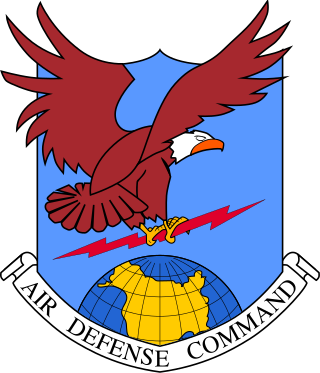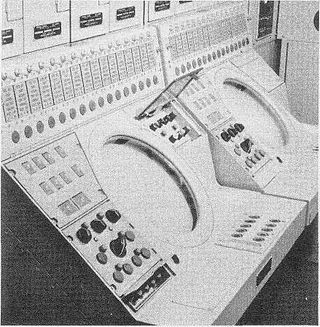Related Research Articles

Fort MacArthur is a former United States Army installation in San Pedro, Los Angeles, California. A small section remains in military use by the United States Air Force as a housing and administrative annex of Los Angeles Air Force Base. The fort is named after Lieutenant General Arthur MacArthur. His son, Douglas MacArthur, would later command American forces in the Pacific during World War II.

Highlands Air Force Station was a military installation in Middletown Township near the borough of Highlands, New Jersey. The station provided ground-controlled interception radar coverage as part of the Lashup Radar Network and the Semi-Automatic Ground Environment network, as well as providing radar coverage for the Highlands Army Air Defense Site. The site's 240 acres (97 ha) is now the Rocky Point section in Hartshorne Woods Park of the Monmouth County Parks System.

Fort Heath was a US seacoast military installation for defense of the Boston and Winthrop Harbors with an early 20th-century Coast Artillery fort, a 1930s USCG radio station, prewar naval research facilities, World War II batteries, and a Cold War radar station. The fort was part of the Harbor Defenses of Boston and was garrisoned by the United States Army Coast Artillery Corps. The fort's military structures have been replaced by a residential complex, including the luxurious Forth Heath Apartments, and recreation facilities of Small Park, which has both a commemorative wall and an historical marker for Fort Heath.
The SAGE radar stations of Air Defense Command were the military installations operated by USAF squadrons using the 1st automated air defense environment and networked by the SAGE System, a computer network. Most of the radar stations used the Burroughs AN/FST-2 Coordinate Data Transmitting Set (CDTS) to automate the operator environment and provide radar tracks to sector command posts at SAGE Direction Centers (DCs), e.g., the Malmstrom Z-124 radar station was co-located with DC-20. The sector/division radar stations were networked by DCs and Manual Control Centers to provide command, control, and coordination for ground-controlled interception of enemy aircraft by interceptors such as the F-106 developed to work with the SAGE System.

Fort Lawton Air Force Station is a closed United States Air Force General Surveillance Radar station. It is located on Fort Lawton in the Magnolia neighborhood of northwest Seattle, Washington. The Air Force inactivated its unit in 1963; while the site remained under Army control until 1974. Today the Federal Aviation Administration (FAA) operates the site as part of the Joint Surveillance System (JSS).
The Fort Meade radar station was a Cold War military site with several sets of radar equipment in various Army and USAF radar networks. The site operated c. 1950 until 1979 and had a Project Nike command post and radar network.
The Martin AN/FSG-1 Antiaircraft Defense System, better known as Missile Master, was an electronic fire distribution center to computerize Cold War air defense (AD) command posts from manual plotting board operations to automated command and control of remote surface-to-air missile (SAM) launch batteries. The 10 United States Army C3 systems used radar netting ("electronic umbrella") at Missile Master military installations for coordinating ground-controlled interception by Nike and MIM-23 Hawk missiles. The vacuum tube fire control logic reduced the time to designate the appropriate missile battery to launch if an enemy target had intruded into a defense area where an AN/FSG-1 system was deployed.

The Sievers Sandberg Reserve Center is a U.S. Army Reserve training installation in New Jersey. It occupies 39 acres (16 ha).

Missile Master was a type of US Army Missile Command military installation for the Cold War Project Nike, each which were a complex of systems and facilities for surface-to-air missile command and control. Each Missile Master had a nuclear bunker housing the Martin AN/FSG-1 Antiaircraft Defense System, as well as additional "tactical structures" for "an AN/FPS-33 defense acquisition radar (DAR) or similar radar, two height-finder radars," and identification friend or foe secondary radar. The radars, along with Automated Data Links (ADL) from remote Nike firing units, provided data into the AN/FSG-1 tracking subsystem with the DAR providing surveillance coverage to about 200 mi (320 km).
The Martin AN/GSG-5 Battery Integration and Radar DIsplay Equipment (BIRDIE) was a transportable electronic fire distribution center for automated command and control of remote surface-to-air missile launch batteries. The solid state radar netting system replaced the vacuum tube AN/FSG-1 at 3 United States Missile Master bunkers and BIRDIEs were deployed at over 25 US locations including Homestead-Miami, Florida; Providence, Rhode Island; and San Francisco. The AN/GSG-5 with 3 consoles was a direction center for up to 16 Nike missile batteries, but a smaller variant with only 1 console and without computer and storage equipment could control only 2 batteries and was the 1st BIRDIE deployed. Several BIRDIE systems were replaced by Hughes AN/TSQ-51 Air Defense Command and Coordination Systems, and the last AADCP with an AN/GSG-5 was at Ft Lawton on July 1, 1973.

The Highlands Army Air Defense Site (HAADS) was a United States Army air defence site in Middletown Township, New Jersey.

The Western Electric System 1393 Radar Course Directing Central (RCDC) was a Cold War complex of radar/computer systems within the overall Improved Nike Hercules Air Defense Guided Missile System. The RCDC was installed at the "battery control areas" of ~5 hectares each which was for commanding a nearby missile Launching Area (LA), firing a missile from the LA, and guiding a launched missile to a burst point near an enemy aircraft.

The Raytheon AN/MSQ-18 Battalion Missile Operations System was a Project Nike command, control, and coordination system for "each associated missile battery" to control a Nike missile as directed from a Raytheon AN/MSQ-28 at the Army Air Defense Command Post. Raytheon Company constructed the AN/MSQ-18 as 2 separate subsystems:
The Martin AN/TSQ-8 Coordinate Data Set was a Project Nike CCCS system for converting data between Army Air Defense Command Posts (AADCP) and Integrated Fire Control sites for missile Launch Areas. The AN/TSQ-8 in the Firing Unit Integration Facility (FUIF) was first installed for each Launch Area controlled from a Martin AN/FSG-1 Antiaircraft Defense System and then later for other Nike CCCS. The system included a "data converter, range computer, summing amplifier, status relay panel, status control panel, problem unit, [and] power control panel".
A command, control, and coordination system (CCCS) was a Cold War computer system for United States command posts to use a single location to coordinate multiple units' ground-controlled interception and may refer to:
The Arlington Heights Army Air Defense Site was a Project Nike Missile Master site near Chicago, Illinois. It operated from 1960 until 1968.

The United States Army's Nike Ajax was the world's first operational guided surface-to-air missile (SAM), entering service in 1954. Nike Ajax was designed to attack conventional bomber aircraft flying at high subsonic speeds and altitudes above 50,000 feet (15 km). Nike was initially deployed in the US to provide defense against Soviet bomber attacks, and was later deployed overseas to protect US bases, as well as being sold to various allied forces. Some examples remained in use until the 1970s.

The Fort Heath radar station was a USAF radar site and US Army Missile Master installation of the joint-use site system (JUSS) for North American Air Defense at a former coastal defense site. The Cold War radar station had 2 USAF AN/FPS-6B height finding radars, 2 Army AN/FPS-6A height finders, an FAA ARSR-1 radar emplaced 1958-9, and an Army nuclear bunker. Arctic Towers were the pedestals for the FPS antennas and radomes, while the Air Route Surveillance Radar was on a 50-foot extension temperate tower adjacent to the Federal Aviation Administration building.
An Air Defense Direction Center (ADDC) was a type of United States command post for assessing Cold War radar tracks, assigning height requests to available height-finder radars, and for "Weapons Direction": coordinating command guidance of aircraft from more than 1 site for ground-controlled interception. As with the World War II Aircraft Warning Service CONUS defense network, a "manual air defense system" was used through the 1950s Along with 182 radar stations at "the end of 1957, ADC operated … 17 control centers", and the Ground Observation Corps was TBD on TBD. With the formation of NORAD, several types of ADDCs were planned by Air Defense Command:
NORAD Control Centers (NCCs) were Cold War "joint direction centers" for command, control, and coordination of ground-controlled interception by both USAF Air Defense Command (ADC) and Army Air Defense Command (ARADCOM). The Joint Manual Steering Group was "formed by the Army and Air Force in July 1957 to support…collocation" of USAF Air Defense Direction Centers and Army Air Defense Command Posts, which began after a January 28, 1958, ADC/ARADCOM meeting with NORAD to "collocate the Fairchild-Geiger facilities" Army contracts for 5 NCCs had been let by August 17, 1958, after 1956 DoD approval for collocation of interim "pre-SAGE semiautomatic intercept systems" and radar squadrons at 10 planned Army Missile Master AADCPs
References
- ↑ Berhow, Mark (2005). US Strategic and Defensive Missile Systems 1950-2004. Taylor, Chris (illustrations). Osprey Publishing. p. 21. ISBN 1-84176-838-3 . Retrieved 2011-09-06.
- ↑ Morgan, Mark L; Berhow, Mark A (2002). Rings of Supersonic Steel (Google Books) (second ed.). Hole in the Head Press. ISBN 0-615-12012-1 . Retrieved 2011-09-13.
- ↑ "New Firing Control System: Army Unveils Missile Mentor" (PDF). Red Bank Register . Red Bank, New Jersey. February 1, 1967. p. 13. Archived from the original (PDF) on 2011-10-13. Retrieved 2011-09-15.
faster, more reliable and less expensive ... replaces the Army's six Missile Master systems...and four...BIRDIE...employed almost five years. ...the original cost of the Missile Master...was in excess of $9 million for each site, while the Missile Mentor costs less than $1 million each. ...[annual] operating and maintenance costs...would be $250,000, [cf. $1 million...of Missile Master. ...50 to 60 persons [cf.] approximately 200 [for] Missile Master ... Missile Mentor...fits compactly into two trailer vans. One van holds the battle station, display consoles for the defense commander and equipment operators, the other houses the computer and circuit panels ...[At] the Highlands Defense Site, the Missile Mentor [is] in the...building once occupied by [the] Missile Master. ...built under a $10 million contract with the Army Missile Command (MICOM).
- ↑ "AN/FSG-1 Missile Master and AN/TSQ-51 Missile Mentor". The Historic Atlantic Highlands Military Reservation (MR). Fort Tilden. November 11, 2005. Retrieved 2011-09-15. (includes image of console in trailer)